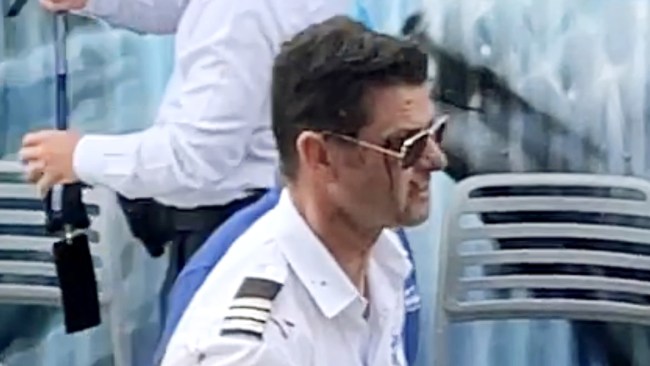The pilot widely recognised as a “hero” for miraculously saving the lives of five passengers aboard a chopper involved in a horror Sea World collision has died.
A new report into the Sea World helicopter crash has revealed the pilot who died had traces of cocaine in his system, but it was unlikely to have impaired his flying motor skills.
The Australian Transport Safety Bureau report has been handed down on the 12-month anniversary of the collision between two joy flight choppers.
AUST Transport Safety Bureau Chief Commissioner Angus Mitchell said there is a “zero tolerance” to drug use when flying.
Mr Mitchell told Sky News Australia that the discovery of cocaine in the pilot’s system has come as “very difficult reading” for people and families involved in the accident.
“Particularly as we didn’t have evidence that it had a contributory element to this incident – but equally it’s something that we do, and we’ve released another report only a matter of months ago where there was a similar finding involved.”
Michael James miraculously saved five passengers’ lives aboard his Eurocopter EC130 which he landed safely on a sandbank after it collided mid-air with another joy ride chopper circulating Queensland’s Gold Coast on January 2, 2021.
Mr James was named a “hero” after he safely stabilised the helicopter despite it being severely damaged from the other helicopter of the same model’s blades smashing through the cockpit’s windscreen.
The “hero” pilot who saved the lives of five of his passengers in a deadly horror Sea World chopper crash has died of cancer. Picture: News Corp Australia
He has now died after he lost his battle with cancer almost 18 months on from the horrific incident.
Mr James, who was diagnosed with cancer in 2023, was farewelled by family and friends in a private funeral on June 4.
It’s understood the 53-year-old never returned to flying after the crash where he spared the lives of New Zealand tourists Elmarie Steenberg, Riaan Steenberg, Edward Stewart and Marle Stewart.
The couples expressed an outpouring of gratitude to Mr James as well as their devastation for the four people who died in the incident, in a statement released shortly after the crash.
“To our pilot, who, through all the chaos, landed the helicopter safely, keeping us and other bystanders safe. You are our hero. Thank you so very much,” the joint statement read.
“Our deepest sympathies and sincere condolences to the injured and the deceased and the families.
“We are grateful and blessed to have been spared but very sad for the people who lost loved ones and the littles on and mum fighting for their lives in hospital.
“Our hearts are so heavy for them.”
A toxicology report has revealed the pilot of a helicopter had traces of cocaine in his system – when it collided with another chopper on the Gold Coast last year.
The Australian Transport Safety Bureau has released an interim report into the Sea World helicopter crash that occurred a year ago in 2023 and killed four people and injured nine others.
The goal is to identify if there were broader safety issues that went into the incident or were contributing factors.
“Although it is unlikely the pilot of XKQ would have had any psychomotor skill impairment on the day of the accident, it is not known whether post-cocaine exposure effects … had any effect on the performance of the pilot,” ATSB said.
ATSB also found that some passengers’ seatbelts weren’t fitted correctly in the accident – although this is not attributed to the tragic collision.
Further investigation also found that seatbelts weren’t fitted by the operator “on a regular basis”.
Loading embed…
Sea World Helicopter’s chief pilot Ashley Jenkinson was killed in the crash, alongside 36-year-old Vanessa Tadros from Sydney and British tourists Ron and Diane Hughes, aged 57 and 65, from Neston, Cheshire.
Ms Tadros’s son Nicholas, who was 10 at the time, suffered critical injuries and subsequently had to have his leg amputated from the knee down.
Victorian woman Winnie de Silva, 33, and her son Leon, nine, were also seriously injured with the latter having suffered brain trauma and placed in an induced coma for some time.
The passengers loaded into the aircraft and the doors closed with Mr James’ assessment at the time being his helicopter would “be clear” of the helicopter and “that it would pass behind them.”
However, at 1356:06, the two helicopters collided after the second helicopter ascended and began tracking south-west while the surviving pilot guided his aircraft approximately south-east.
An interim report released by The Australian Transport Safety Bureau (ATSB) one year on from the tragedy in January revealed pilot Mr Jenkinson had traces of cocaine in his system at the time of the crash.
However, ATSB Chief Commissioner Angus Mitchell ruled the trace of cocaine in Mr Jenkinson’s system would not have caused the fatal collision.
He said the cocaine in the pilot’s system was at “very low concentrations” and his exposure to the drug was unlikely to have occurred in the 24 hours before the collision.
He said the survivors and families of those killed “want to not only understand how the tragedy unfolded but equally, and most importantly, why it occurred.
“And why didn’t the safety equipment, processes and procedures that are designed to prevent an accident like this work on this occasion?”
The ATSB identified no pre-existing defects in either helicopter which would have affected normal operation and it continues to investigate the tragedy.

